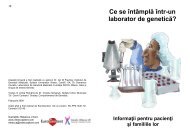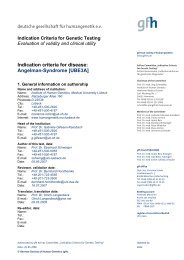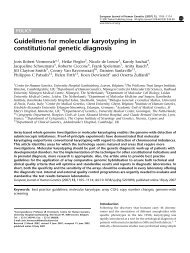Cytogenetic Guidelines and Quality Assurance - EuroGentest
Cytogenetic Guidelines and Quality Assurance - EuroGentest
Cytogenetic Guidelines and Quality Assurance - EuroGentest
Create successful ePaper yourself
Turn your PDF publications into a flip-book with our unique Google optimized e-Paper software.
level of resolution for studies to establish common<br />
aneuploidies in constitutional cytogenetics. A 550<br />
bphs (QAS 6) level should be the minimum st<strong>and</strong>ard<br />
for referrals of mental retardation, birth defects, dysmorphic<br />
children or couples with recurrent pregnancy<br />
loss.<br />
Where it is not possible to achieve the minimum<br />
quality for the referral reason, <strong>and</strong> no clinically<br />
significant abnormality is detected, the report should<br />
be suitably qualified whilst not encouraging repeat<br />
invasive procedures when these are NOT clinically<br />
justified.<br />
4.4 ANALYSIS<br />
4.4.1 KARYOTYPING/<br />
CHROMOSOME ANALYSIS<br />
In general, a minimum of 5 cells should be fully analysed<br />
for constitutional analysis <strong>and</strong> 10 cells for a haematological<br />
analysis. If metaphase analysis involves a<br />
comparison of every set of homologues (including X<br />
& Y), b<strong>and</strong> by b<strong>and</strong>, then a minimum of 3 metaphases<br />
can be fully analysed. If one of the homologue pair is<br />
involved in an overlap with another chromosome the<br />
pair of homologues should be independently scored to<br />
ensure there is no structural rearrangement.<br />
Additional cells may be counted depending on laboratory<br />
policy. An extended analysis <strong>and</strong>/or cell count is<br />
warranted when mosaicism is clinically indicated or<br />
suspected. The laboratory should have written protocol<br />
for the analysis criteria.<br />
Hyper- <strong>and</strong> hypodiploid <strong>and</strong> polyploid cells should be<br />
fully analysed in constitutional <strong>and</strong> haematological<br />
analysis.<br />
All cases should have an image or a slide stored for<br />
later review (see section 11.12.1).<br />
Refer to the current ISCN for the definition of a clonal<br />
abnormality.<br />
4.4.2 CHECKING<br />
Checking of all cases by a second qualified cytogeneticist<br />
is essential. A senior supervisor or an<br />
experienced cytogeneticist should check the analysis.<br />
4.5 INTRODUCTION OF NEW LABORATORY<br />
PROCEDURES<br />
A laboratory should, when starting any new diagnostic<br />
service, have a protocol for training staff <strong>and</strong> testing<br />
new equipment so patients are not at risk from inappropriate<br />
h<strong>and</strong>ling of equipment/slides etc. One way<br />
of doing this is to divide the samples, <strong>and</strong> send half to<br />
an experienced laboratory until the necessary level of<br />
competence is achieved. Validation <strong>and</strong> SOPs of these<br />
procedures is required.<br />
4.5.1 USE OF MOLECULAR TECHNIQUES<br />
When molecular genetic techniques are more sensitive<br />
than conventional cytogenetics, they should be used<br />
once the method has been validated, (e.g. for Angelman<br />
or Prader Willi syndrome, other microdeletion<br />
syndromes, Fragile X syndrome, etc). This could<br />
result in onward referral of cases if a laboratory is<br />
unable to undertake such analysis. Exclusion of other<br />
19<br />
chromosome abnormalities may still be required in<br />
most cases.<br />
5. SPECIFIC CHROMOSOMAL ANALYSIS<br />
5.1 PRENATAL<br />
5.1.1 AMINOCYTE CULTURES<br />
To minimise the risk of contamination, or culture loss<br />
due to incubator failure, duplicate cultures should<br />
preferably be h<strong>and</strong>led separately, kept in separate<br />
incubators, if possible, running on a different electrical<br />
circuits. Prenatal cultures should be maintained with<br />
two different cell culture media, or with different<br />
batches of the same cell culture media <strong>and</strong> other reagents.<br />
The possibility of maternal cell contamination,<br />
pseudomosaicism, true mosaicism <strong>and</strong> in vitro<br />
aberrations must be recognised <strong>and</strong> the system of<br />
culture <strong>and</strong> analysis used designed to detect <strong>and</strong><br />
differentiate these problems.<br />
Harvesting or subculturing of all cell cultures from an<br />
individual sample together should be avoided.<br />
If possible back up cultures should be kept until the<br />
final report is written.<br />
Facilities should be available for freezing viable cells,<br />
e.g. for unresolved cases of abnormal foetal pathology.<br />
5.1.2 CHORIONIC VILLI CULTURES<br />
Before a CVS sample is cultured it must be dissected<br />
<strong>and</strong> maternal decidua separated from the villus to<br />
reduce the chance of maternal cell contamination. It<br />
should be clear from the referral form whether the<br />
sample has been dissected or not prior to its’ arrival in<br />
the laboratory. If an initial cytogenetic diagnosis is<br />
made on short-term preparations, a long term culture<br />
should be available for confirmation, in order to<br />
minimise problems of interpretation (Eucromic 1997,<br />
ACC Collaborative study, 1994). Analysis solely on<br />
short-term incubation preparations (direct preparations)<br />
is not recommended (Eucromic 1997, ACC<br />
Collaborative study, 1994). If the sample is of an<br />
inadequate size for both short <strong>and</strong> long term cultures,<br />
analysis from a long term culture is recommended.<br />
5.1.3 FOETAL BLOOD CULTURES<br />
The foetal blood sample should be checked to ensure<br />
it is not mixed with maternal blood, <strong>and</strong> originates<br />
only from the foetus. Several haematological methods<br />
are available. (Alkaline Phosphatase, Kleinhauer,<br />
Coulter counter sizing). Both foetal blood <strong>and</strong><br />
amniotic fluid samples should be analysed unless there<br />
is a valid reason not to do so e.g. abnormal foetal<br />
blood result <strong>and</strong> pregnancy terminated.<br />
5.1.4 MOSAICISM IN PRENATAL STUDIES<br />
Two or three cultures should be set up for each<br />
sample. Analysis of a second or third culture is<br />
essential in cases of suspected mosaicism or pseudomosaicism<br />
e.g. trisomy 2 or where the abnormality is<br />
not consistent with continued fetal development (see<br />
Hsu et al., 1996, 1997). In general, if the same abnormality<br />
is present in two independent cultures,<br />
mosaicism is confirmed.<br />
For in situ preparations, analysing cells from one cell<br />
culture may be sufficient if not all from the same















